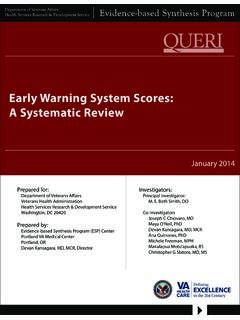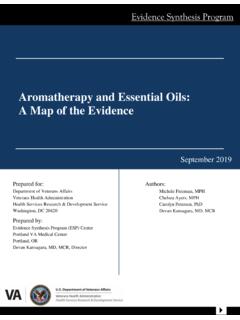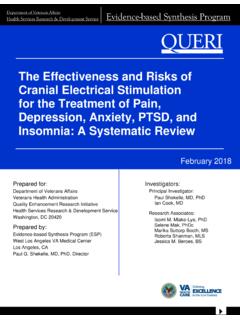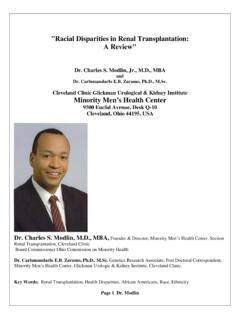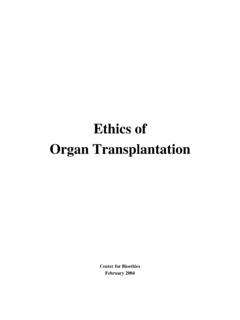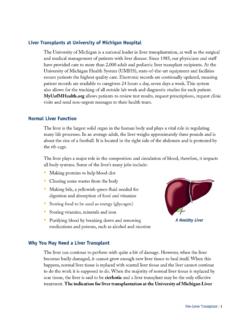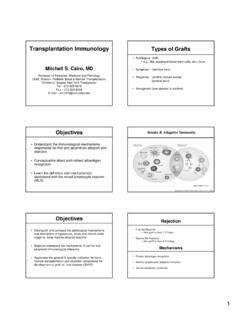Transcription of Fecal Microbiota Transplantation for
1 Evidence-based Synthesis Program Department of Veterans Affairs Health Services Research & Development Service July 2014 Fecal Microbiota Transplantation for Clostridium Difficile Infection: A Systematic Review of the Evidence Prepared for: Department of Veterans Affairs Veterans Health Administration Quality Enhancement Research Initiative Health Services Research and Development Service Washington, DC 20420 Prepared by: Evidence-based Synthesis Program (ESP) Center Minneapolis VA Medical Center Minneapolis, MN Timothy J. Wilt, , , Director Investigators: Principal Investigator: Dimitri Drekonja, , Co-Investigators: Jon Reich, Selome Gezahegn, Nancy Greer, Aasma Shaukat, , Timothy Wilt, , Research Associates: Roderick MacDonald, Indy Rutks, 4 Fecal Microbiota Transplantation Evidence-based Synthesis Programi 9contents34 PREFACE Quality Enhancement Research Initiative s (QUERI) Evidence-based Synthesis Program (ESP) was established to provide timely and accurate syntheses of targeted healthcare topics of particular importance to Veterans Affairs (VA) clinicians, managers and policymakers as they work to improve the health and healthcare of Veterans.
2 The ESP disseminates these reports throughout the VA, and some evidence syntheses inform the clinical guidelines of large professional organizations. QUERI provides funding for four ESP Centers and each Center has an active university affiliation. The ESP Centers generate evidence syntheses on important clinical practice topics, and these reports help: develop clinical policies informed by evidence; guide the implementation of effective services to improve patientoutcomes and to support VA clinical practice guidelines and performancemeasures; and set the direction for future research to address gaps in clinical 2009, the ESP Coordinating Center was created to expand the capacity of HSR&D Central Office and the four ESP sites by developing and maintaining program processes. In addition, the Center established a Steering Committee comprised of QUERI field-based investigators, VA Patient Care Services, Office of Quality and Performance, and Veterans Integrated Service Networks (VISN) Clinical Management Officers.
3 The Steering Committee provides program oversight, guides strategic planning, coordinates dissemination activities, and develops collaborations with VA leadership to identify new ESP topics of importance to Veterans and the VA healthcare system. Comments on this evidence report are welcome and can be sent to Nicole Floyd, ESP Coordinating Center Program Manager, at Recommended citation: Drekonja D, Reich J, Gezahegn S, Greer N, Shaukat A, MacDonald R, Rutks I, and Wilt TJ. Fecal Microbiota Transplantation for Clostridium Difficile Infection: A Systematic Review of the Evidence. VA ESP Project #09-009; 2014. This report is based on research conducted by the Evidence-based Synthesis Program (ESP) Center located at Minneapolis VA Medical Center, Minneapolis, MN, funded by the Department of Veterans Affairs, Veterans Health Administration, Office of Research and Development, Quality Enhancement Research Initiative.
4 The findings and conclusions in this document are those of the author(s) who are responsible for its contents; the findings and conclusions do not necessarily represent the views of the Department of Veterans Affairs or the United States government. Therefore, no statement in this article should be construed as an official position of the Department of Veterans Affairs. Drs. Drekonja and Shaukat are principal proponents of the following randomized controlled trial currently under review for planning and conduct through the VA Cooperative Studies Program: The Veterans Affairs Fecal Microbiota Therapy Trial for Recurrent Clostridium difficile Infection: A Planning Request for a VA Cooperative Study . No other investigators have any affiliations or financial involvement (eg, employment, consultancies, honoraria, stock ownership or options, expert testimony, grants or patents received or pending, or royalties) that conflict with material presented in the report.
5 Fecal Microbiota Transplantation Evidence-based Synthesis Programii 9contents34 TABLE OF CONTENTS EXECUTIVE SUMMARY Introduction .. 1 Purpose of Review .. 1 Methods .. 2 Data Sources and Searches .. 2 Study Selection .. 2 Data Abstraction and Quality Assessment .. 2 Data Synthesis and Analysis .. 2 Results .. 2 Results of Literature Search .. 2 Summary of Results for Key Questions .. 3 Executive Summary Figure. Reported Resolution of Symptoms after Initial FMT for Recurrent CDI, All Routes for Infusion of Donor Feces .. 4 Discussion .. 5 Key Findings and Strength of Evidence .. 5 Applicability .. 5 Research Gaps/Future Research .. 5 Conclusions .. 6 Abbreviations Table .. 6 INTRODUCTION .. 7 Purpose of Review .. 9 METHODS Topic 10 Search Strategy .. 10 Study Selection .. 10 Data Abstraction .. 11 Quality Assessment .. 11 Data Synthesis .. 11 Rating the Body of Evidence.
6 11 Peer Review .. 11 RESULTS Literature Flow .. 12 Overview .. 12 Fecal Microbiota Transplantation Evidence-based Synthesis Programiii 9contents34 Key Question #1. What is the effectiveness of Fecal Microbiota Transplantation for recurrent CDI compared to standard therapy? Does effectiveness vary by method of Transplantation ? .. 15 Effectiveness of FMT Compared to Standard Therapy .. 15 Effectiveness by Method of Transplantation .. 15 Results by Method of Transplantation .. 17 Recurrent CDI Upper Gastrointestinal Tract .. 17 Recurrent CDI Colonoscopy .. 22 Recurrent CDI Enema .. 28 Recurrent CDI Upper Gastrointestinal Tract and Colonoscopy .. 31 Key Question #2. What is the effectiveness of Fecal Microbiota Transplantation for refractory CDI compared to standard therapy? Does effectiveness vary by method of Transplantation ? .. 32 Refractory CDI Colonoscopy.
7 32 Refractory CDI Enema .. 34 Key Question #3. What is the effectiveness of Fecal Microbiota Transplantation as initial therapy for CDI compared to standard therapy? Does effectiveness vary by method of Transplantation ? .. 35 Key Question #4. What are the harms of Fecal Microbiota Transplantation therapy compared to standard therapy for initial, recurrent, or refractory CDI? Do the harms vary by method of Transplantation ? .. 36 Key Question #5. Is the procedure acceptable to patients? Does patient acceptability vary by method of Transplantation ? .. 37 SUMMARY AND DISCUSSION Summary of Evidence .. 40 Limitations .. 41 Publication Bias .. 41 Study Quality .. 41 Heterogeneity .. 42 Applicability .. 42 Research Gaps/Future Research .. 42 Conclusions .. 43 REFERENCES .. 45 TABLES Table 1. Outcomes Reported by CDI Status and Method of Transplantation .. 13 Table 2.
8 Pooled Results for Reported Resolution of Symptoms after Initial FMT for Recurrent CDI .. 17 Table 3. Summary of Patient Baseline Characteristics Recurrent CDI, Studies of Upper GI Tract Infusion of Donor Feces .. 18 Table 4. Amount of Fecal Material and FMT Procedure Recurrent CDI, Studies of Upper GI Tract Infusion of Donor Feces .. 20 Table 5. Outcomes Recurrent CDI, Studies of Upper GI Tract Infusion of Donor Feces .. 21 Table 6. Summary of Patient Baseline Characteristics Recurrent CDI, Studies Using Colonoscopic Infusion of Donor Feces .. 23 Table 7. Amount of Fecal Material and Liquid Used in FMT Recurrent CDI, Studies Using Colonoscopic Infusion of Donor Feces .. 25 Fecal Microbiota Transplantation Evidence-based Synthesis Programiv 9contents34 Table 8. Outcomes - Recurrent CDI, Studies Using Colonoscopic Infusion of Donor Feces .. 27 Table 9. Summary of Patient Baseline Characteristics Recurrent CDI, Studies of Enema for Infusion of Donor Feces.
9 29 Table 10. Amount of Fecal Material and Liquid Used in FMT Recurrent CDI, Studies of Enema for Infusion of Donor Feces .. 30 Table 11. Outcomes-Recurrent CDI, Studies of Enema for Infusion of Donor Feces .. 31 Table 12. Open Trials of FMT for Adults or Adults and Children .. 44 FIGURES Figure 1. Literature Flow Chart .. 12 Figure 2. Reported Resolution of Symptoms after Initial FMT for Recurrent CDI, Upper GI Tract Infusion of Donor Feces .. 20 Figure 3. Reported Resolution of Symptoms after Initial FMT for Recurrent CDI, Studies Using Colonoscopic Infusion of Donor Feces .. 26 Figure 4. Reported Resolution of Symptoms after Initial FMT for Recurrent CDI, Studies of Enema for Infusion of Donor Feces .. 30 APPENDIX A. SEARCH STRATEGY .. 51 APPENDIX B. PEER REVIEw COMMENTS/AUTHOR RESPONSES .. 52 APPENDIX C. EVIDENCE TABLES .. 58 Table 1. Study Characteristics .. 58 Table 2.
10 Outcomes after Initial Transplant and Adverse Events .. 72 Table 3. Outcomes after Repeat Transplant .. 77 Fecal Microbiota Transplantation Evidence-based Synthesis Program1 9contents34 ExECuTivE SummARy iNTROduCTiON Since its discovery as the cause of pseudomembranous colitis in 1978, Clostridium difficile (C. difficile) has become an increasingly important pathogen. Initially, C. difficile infection (CDI) was largely confined to patients with healthcare exposure; however, it is now also affecting those with no or limited contact with the healthcare system. In 2013, the Centers for Disease Control and Prevention placed C. difficile into its top threat category of urgent in its first threat report on antimicrobial resistance. A major challenge in treating CDI is the high rate of recurrent disease. Recurrence occurs in 15-30% of patients, and among those with a single episode of recurrence, the risk of further recurrence increases after each episode.


